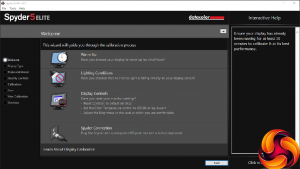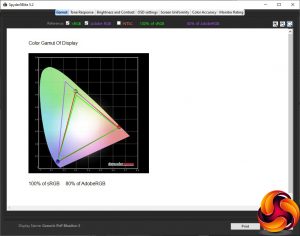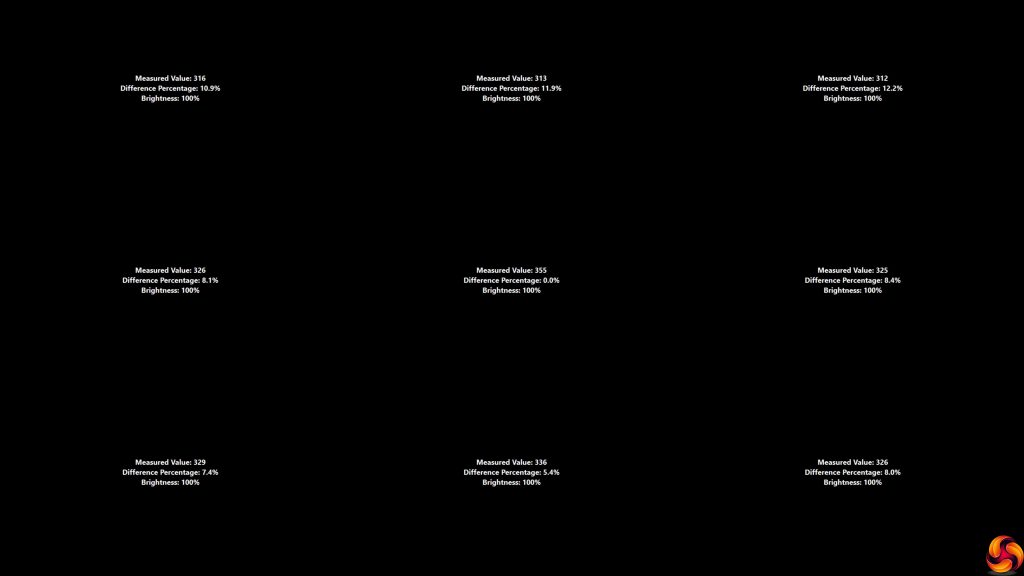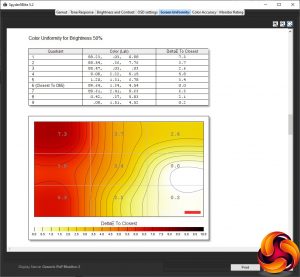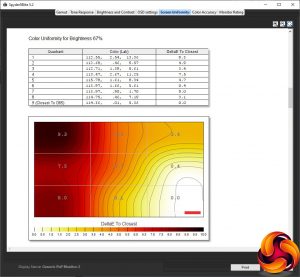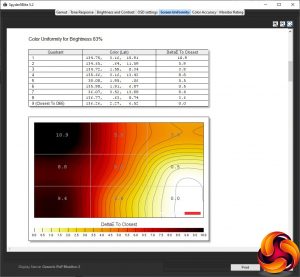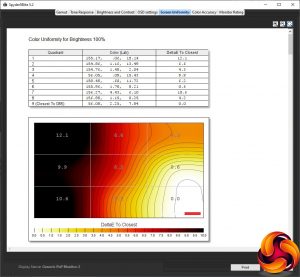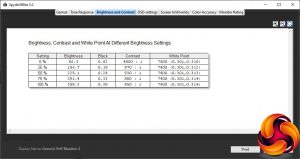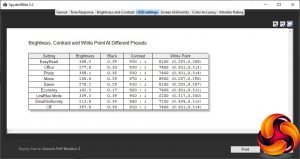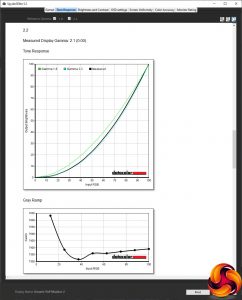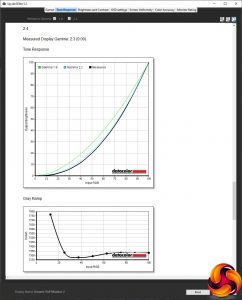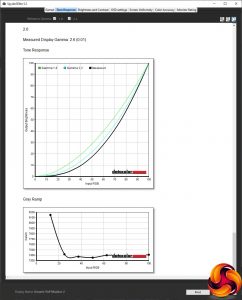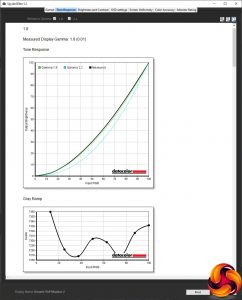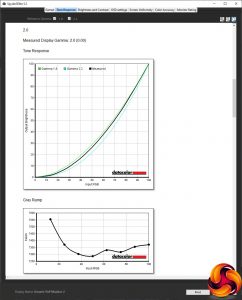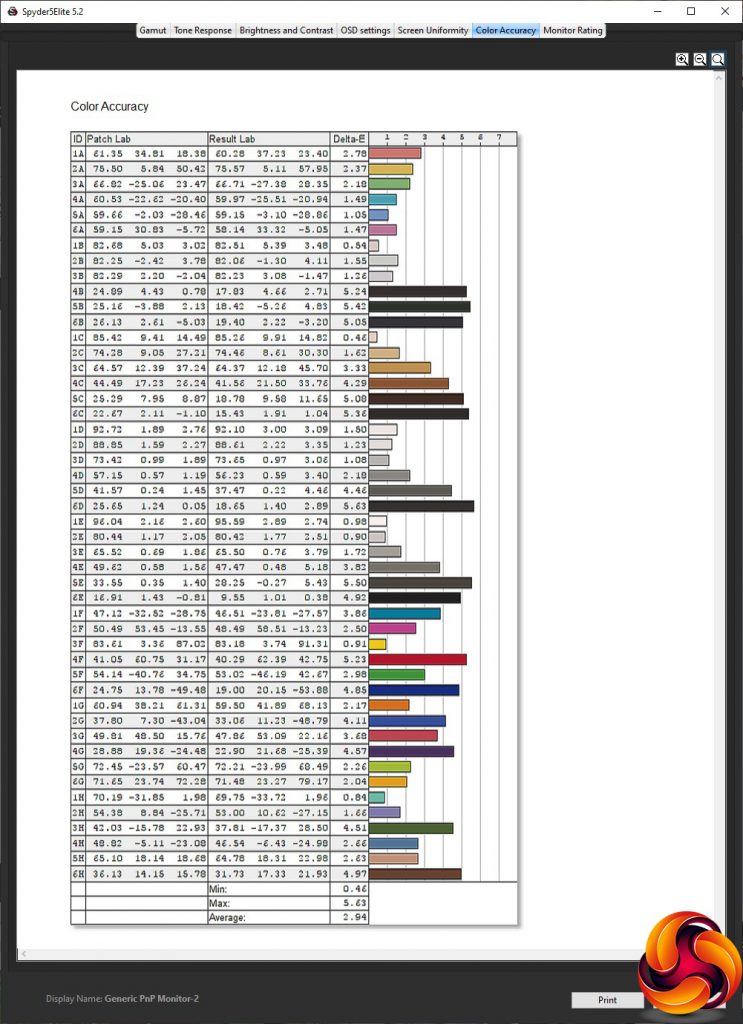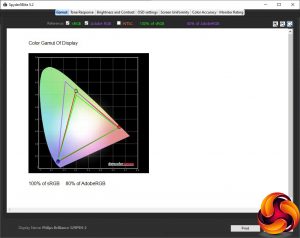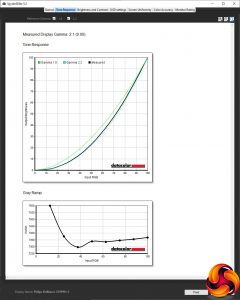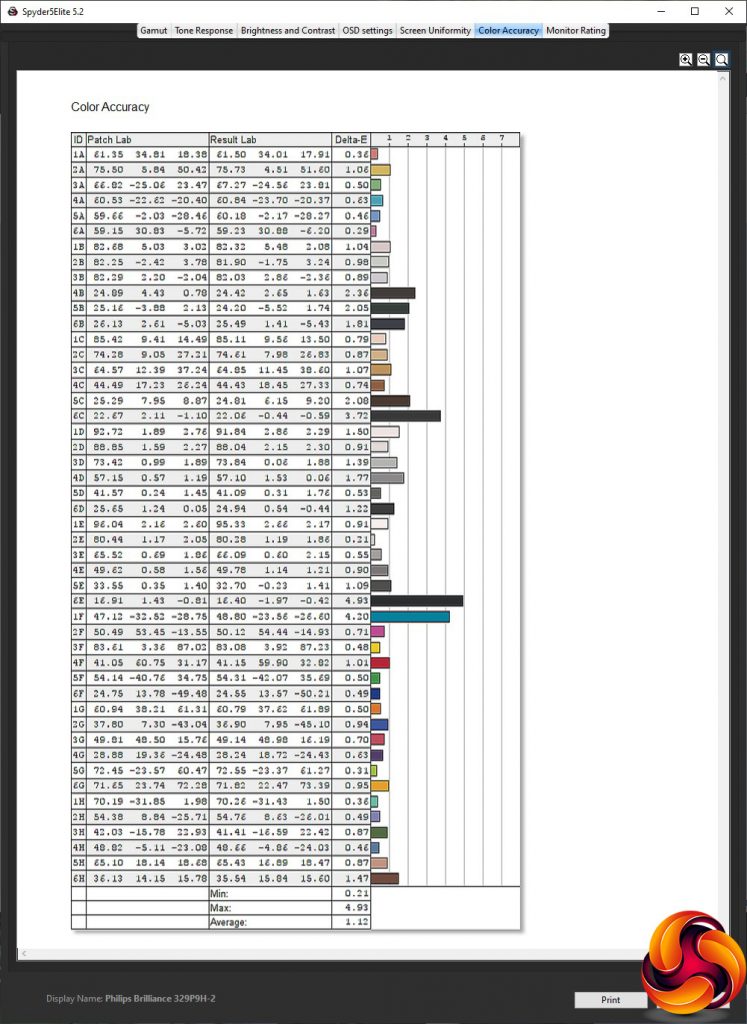Our main test involves using a DataColor Spyder Elite 5 Colorimeter to assess a display’s image quality. The device sits on top of the screen while the software generates colour tones and patterns, which it compares against predetermined values to work out how accurate the screen is.
The results show –
- A monitor’s maximum brightness in candelas or cd/m2 at various levels set in the OSD.
- A monitor’s contrast ratio at various brightness levels in the OSD.
- The brightness deviation across the panel.
- The black and white points.
- The colour accuracy, expressed as a Delta E ratio, with a result under 3 being fine for normal use, and under 2 being great for colour-accurate design work.
- The exact gamma levels, with a comparison against preset settings in the OSD.
We first run this test with the display in its default, out-of-the-box state, with all settings on default. We then calibrate the screen using the Spyder software and run the test again.
We always test the display subjectively on the Windows desktop, using it for general tasks such as browsing and word processing, and with games as well, even if the display is not intended solely for that purpose.
We pay careful attention to any artefacts, ghosting or motion blur, and enable any gaming-specific features, such as adaptive-sync settings like G-Sync or FreeSync, using a compatible graphics card in our test PC.
We performed the quality tests on the 329P9H at its native 3,840 x 2,160 resolution in the default mode using the HDMI connection. Our test system was equipped with an AMD Radeon Vega Frontier Edition graphics card.
Things get off to a promising start with a decent gamut reading of 100 per cent sRGB and 80 per cent of AdobeRGB.
However, brightness uniformity is merely mediocre, with the top edge being the most aberrant.
Colour uniformity is also quite deviant, particularly as the brightness increases.
The 329P9H slightly exceeds its 350cd/m2 brightness rating, hitting 359.3cd/m2 at its top 100 per cent setting (which is the default). The brightness increases in a fairly uniform fashion, although zero per cent is a still quite bright 86.3cd/m2.
The white point is reassuringly stable across the range at 7400K, only increasing slightly to 7500K, although these readings are higher than the default setting is supposed to be, which is 6500K. Contrast is as expected for an IPS panel – hovering around the 900:1 mark, apart from when the brightness level reaches zero.
The SmartImage presets provide a decent range of options. EasyRead is very similar to the default mode, using full brightness and contrast, but a cooler 8100K white point than the 7400K you get out of the box. Office mode keeps the 7400K white point and 930:1 contrast, but drops the brightness down to 277cd/m2. Photo mode, however, is exactly the same as the default settings, with full brightness, full contrast, and the standard 7400K white point.
Movie mode takes the usual tactic of cinema-watching presets, with a very cool 8900K white point. The contrast is reduced slightly to 890:1, and the brightness drops to 255cd/m2. Game mode opts for the top 930:1 contrast, but with a cool 8100K white point and reduced 270.2cd/m2 brightness. Economy mode naturally drops the brightness right down to 142.3cd/m2, with a lower contrast of 860:1, but a standard 7400K white point.
LowBlue Mode unsurprisingly has the warmest white point, at 6200K, but also the highest contrast at 960:1 and highest brightness at 369.3cd/m2, noticeably above the panel's rating. Finally, SmartUniformity is a bit of an oddity. The brightness is a midrange 213cd/m2, and the white point of 7200K is close to standard. But contrast has dropped considerably to 550:1.
The gamma options don't provide quite the uniform range we would have hoped for. The 1.8 setting is spot on, as is 2.0, but the 2.2 setting under-reports as 2.1, and 2.4 as 2.3. Then the 2.6 setting is spot on again at 2.6.
We had hoped that a professional screen costing this much and using an IPS panel would blow us away with its colour accuracy, but we have to admit being a little disappointed with the merely decent average deviation of 2.94. The 329P9H was therefore an obvious candidate for calibration using the Spyder system.
No change to the gamut, which remains a good 100 per cent of sRGB and 80 per cent of AdobeRGB.
We only retested the 2.2 gamma setting, which remains slightly off at 2.1.
The good news is that colour accuracy improves a lot with calibration, to an excellent 1.12 average deviation. This is close to the best we have seen.
Overall, performance is a very mixed bag. You can clearly get excellent colour accuracy from this monitor, but you need calibration to get it, and brightness and colour uniformity are both a bit suspect. You do get a useful range of options from the presets, however, and this screen hits its promised brightness and contrast (the Spyder always tends to under-report contrast).
After testing and calibrating the screen, we tried a few professional tasks such as image editing with Photoshop and video editing with Adobe Premiere Pro CC 2019. As with other 4K screens this size we've tested, the desktop real estate and detail were most enjoyable, and as we were doing this after calibration, the colour accuracy was a welcome reassurance. We also tried a few rounds of CS:GO, which were fine but the lack of a high refresh was noticeable.
Be sure to check out our sponsors store EKWB here
 KitGuru KitGuru.net – Tech News | Hardware News | Hardware Reviews | IOS | Mobile | Gaming | Graphics Cards
KitGuru KitGuru.net – Tech News | Hardware News | Hardware Reviews | IOS | Mobile | Gaming | Graphics Cards



